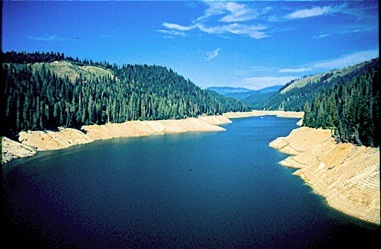Black Rock is not a recreation site

The Bureau of Reclamation’s cost-benefit study projects that as many as a half-million people will visit Black Rock reservoir for recreational purposes. This astonishing figure is based on comparisons with Banks Lake and Potholes Reservoir in the Columbia Basin Project. The study contains no discussion of why Black Rock’s bleak landscape would be considered as appealing as the dramatic basalt cliffs of Banks Lake, or the unique bird and wildlife-watching opportunities at Potholes.
The Bureau’s study also does not explain how the annual drawdown of Black Rock reservoir, averaged at 50 feet, but potentially up to 225 feet, would affect visitors. By way of comparison, Banks Lake drawdown is 5 feet in the summer, and a proposal to draw it down another 5 feet has drawn significant opposition from recreational users.
To review the Banks Lake Drawdown environmental impact statement, click here.
Drawdown reservoirs do not make good recreational sites. For example, Dworshak Reservoir, in north-central Idaho, is drawn down 155 feet per year for flood control and flow augmentation purposes. When built, Dworshak created expectations in the local community that the reservoir would generate economic benefits as a recreation site. These expectations were inconsistent with the Dworshak’s purpose, but the Corps of Engineers failed to dispel them. The Bureau’s emphasis on Black Rock as a recreation site will create similar problems.
The Bureau’s recreation economics analysis is deficient in other respects. It fails to calculate the costs of developing recreational facilities at the Black Rock reservoir. Thus the study claims the benefits, but without assessing how much the public would pay to build and maintain parks, campgrounds, boat ramps, put-and-take fisheries and other facilities to serve 500,000 visitors each year. The study also acknowledges that it does not consider “site-substitution” – that is, how many visitors would substitute Black Rock for another destination where they would have spent the same recreation dollars.
The Yakima Basin Storage Alliance has announced a forthcoming study to identify and promote Black Rock’s recreational benefits. According to YBSA materials, Black Rock could serve as both as a recreational lake and provide water for new golf courses and a master planned development.
Black Rock boosters seem to believe that a “world class resort” would succeed on the banks of a water supply reservoir intended to shore up agricultural supply during drought conditions. Who would invest in such a facility? Who owns property in the Black Rock Valley?
Proposals to utilize Black Rock reservoir supply for new golf courses and subdivisions conflict with the intent of the project. Black Rock is supposed to substitute for existing water diversions from the Yakima, not create new demand that cannot be met and will simply exacerbate water crises. The concept of using Black Rock reservoir water to build new recreation sites does not comport with the justifications for the project.
Ultimately, decision makers must think very carefully about whether it makes sense to even promote Black Rock as a recreational project, much less use the idea as a basis for building the project. Failure to do so can only result in disappointment.
Next: Yakima Water Solutions

Columbia Institute for Water Policy
Black Rock Follies © 2007


Dworshak Dam, full pool.
Photo: U.S. Army Corps of Engineers
Bathtub ring, Dworshak Dam, Idaho. Drawing down the reservoir to help fish conflicts with recreation use. See, for example, “New Fight over Dworkshak Reservoir water.”
Photo: John Osborn
Bathtub ring, Lake Roosevelt. Drawing down the reservoir to help fish conflicts with recreation use. (Photo: Rachael Paschal Osborn)

Banks Lake, Columbia Basin Project. Drawdown is 5 feet in the summer, and a proposal to draw it down another 5 feet has drawn significant opposition from recreational users. Compare this with the drawdown at the proposed Black Rock reservoir: an average of 50 feet, but potentially up to 225 feet. The Bureau of Reclamation does not discuss impacts on visitors.
Photo: U.S. Bureau of Reclamation,
“Banks Lake Drawdown, Final Environmental Impact Statement.”
Drawdown Hurts Economy
“A study by the University of Idaho buttresses the complaints of local merchants that the annual summer drawdown of Dworshak Reservoir hurts Clearwater County's economy.
“The toll over the years: $4.5-million lost annual sales; 125 fewer jobs; and more than $1.4 million a year in vanished earnings.
“Dworshak Dam was completed in 1973 to provide flood control, hydropower and recreation. The lower water has made summer recreation all but nonexistent.” from Ag News: The Growers’ Guide, 2001















